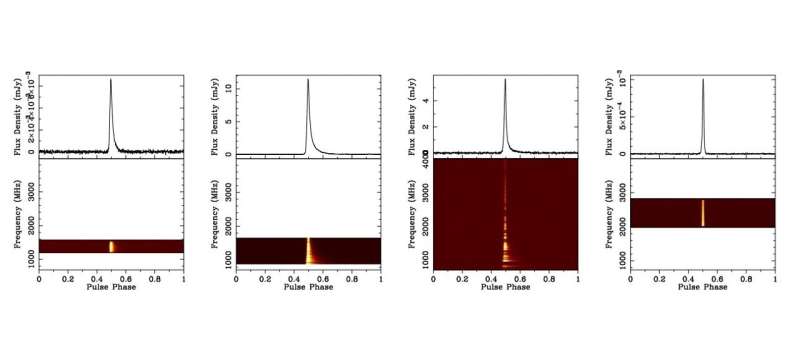July 26, 2024 report
This article has been reviewed according to Science X's editorial process and policies. Editors have highlighted the following attributes while ensuring the content's credibility:
fact-checked
preprint
trusted source
proofread
Study sheds more light on the nature of pulsar PSR J1227−6208

Astronomers from the Max Planck Institute for Radio Astronomy (MPIfRA) in Bonn, Germany and elsewhere have inspected a recycled pulsar known as PSR J1227−6208. The new study, published July 18 on the preprint server arXiv, provides important insights into the nature of this pulsar.
Pulsars are highly magnetized, rotating neutron stars emitting a beam of electromagnetic radiation. They are usually detected in the form of short bursts of radio emission; however, some of them are also observed via optical, X-ray and gamma-ray telescopes.
The so-called recycled pulsars are old pulsars that have been spun up or "recycled" through accretion of matter from a companion star in a close binary system. The more massive and evolved the companion star is at the onset of the mass transfer, the slower is the final spin rate of the recycled pulsar. Therefore, recycled pulsars with massive companions, such as carbon monoxide (CO) or oxygen/neon/magnesium composition (ONeMg) white dwarfs (WD) or neutron stars, are much slower rotators, in general, when compared to millisecond pulsars (MSPs) with helium (He) WD companions.
PSR J1227−6208 is a mildly recycled pulsar with a spin period of approximately 34.5 milliseconds. It has a massive companion, with a minimum mass of about 1.27 solar masses (assuming a pulsar mass of 1.35 solar masses). The orbital period of the system is 6.72 days.
A team of astronomers led by MPIfRA's Miquel Colom i Bernadich has taken a closer look at PSR J1227−6208. They employed Parkes and MeerKAT radio telescopes to conduct emission and timing analysis of this pulsar, finding that it belongs to the emerging class of massive recycled pulsar−ONeMg WD systems.
Based on the collected data, the researchers calculated that the mass of the pulsar is between 1.16 and 1.69 solar masses, while the mass of the companion star is estimated to be within the range of 1.21-1.47 solar masses. The system has a very small orbital eccentricity—at a level of 0.00115.
According to authors of the study, the estimated masses and orbital eccentricity almost exclude the possibility that the companion may be a neutron star, favoring the white dwarf scenario. They assume that this object is a massive ONeMg white dwarf close to the Chandrasekhar limit (the maximum mass of a stable white dwarf, about 1.4 solar masses).
The astronomers noted that taking into account the relatively large spin period of PSR J1227−6208, the pulsar has likely accreted no more than 0.0045 solar masses during the recycling process. However, they added that if the accretion occurred in a time period significantly shorter than 100,000 years, this would point to either a super-Eddington accretion rate or a large spin-up efficiency.
The study found that the pulse profile of PSR J1227−6208 has a steep flux density spectral index and a flat scattering index. It was also found that around 15% of the pulsar's emission is linearly polarized.
More information: Miquel Colom i Bernadich et al, PSR J1227–6208 and its massive white dwarf companion: pulsar emission analysis, timing update and mass measurements, arXiv (2024). DOI: 10.48550/arxiv.2407.13593
Journal information: arXiv
© 2024 Science X Network





















